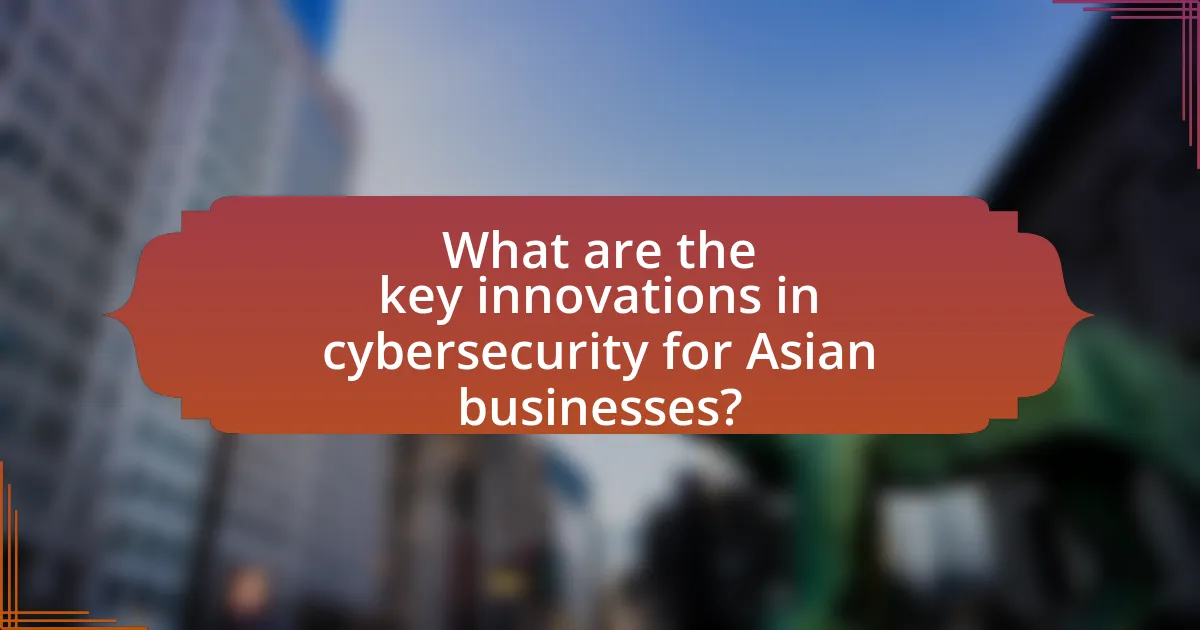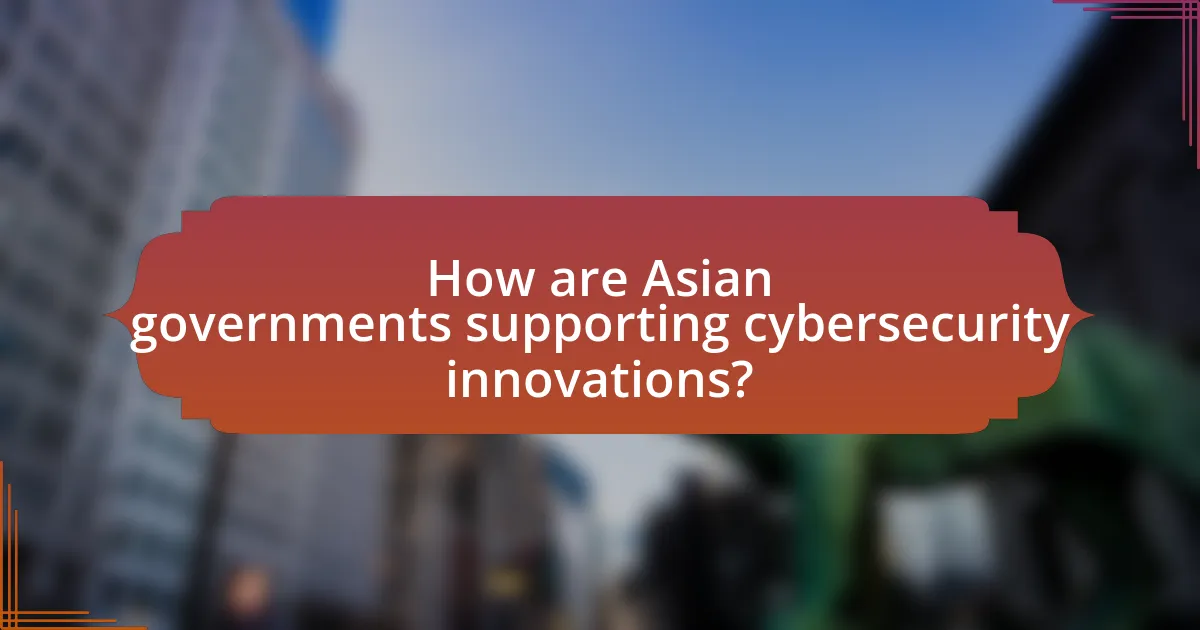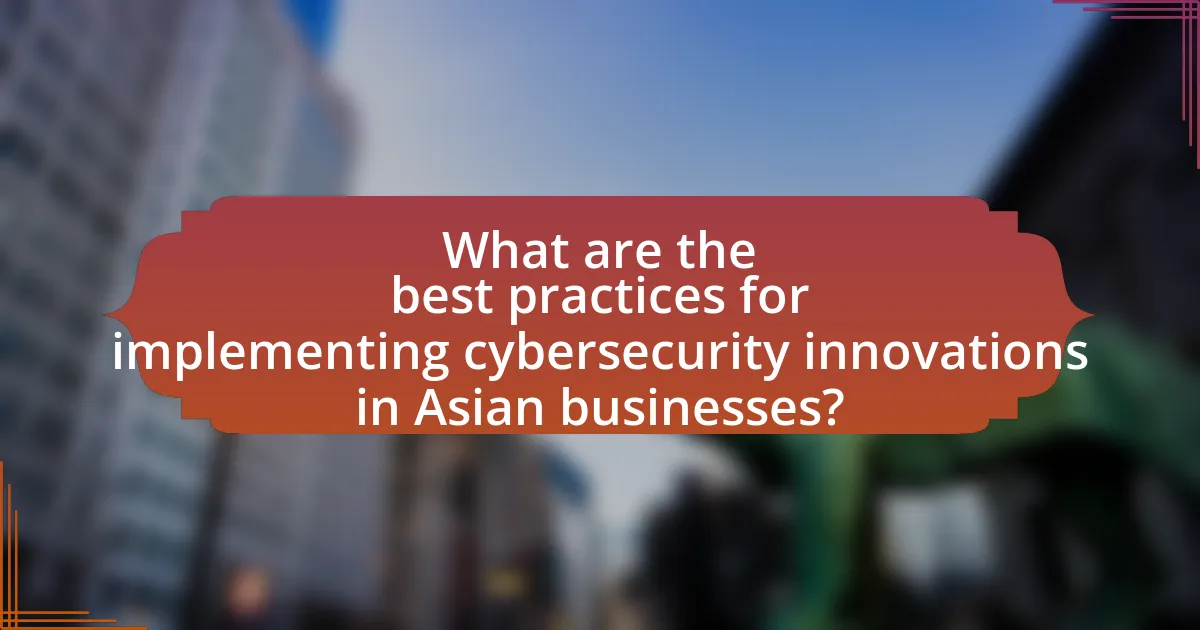The article focuses on key innovations in cybersecurity for Asian businesses, highlighting the adoption of artificial intelligence (AI), advanced encryption technologies, and zero-trust security models. It discusses how these innovations address specific cybersecurity challenges, including increasing cyberattacks and data breaches, which have surged in recent years. The article also examines prevalent threats in the Asian business landscape, the role of technology in enhancing security measures, and the importance of government support and collaboration in fostering cybersecurity advancements. Additionally, it outlines best practices for implementing these innovations and the potential risks of not adopting advanced cybersecurity measures.

What are the key innovations in cybersecurity for Asian businesses?
Key innovations in cybersecurity for Asian businesses include the adoption of artificial intelligence (AI) for threat detection, advanced encryption technologies, and the implementation of zero-trust security models. AI enhances the ability to identify and respond to cyber threats in real-time, significantly reducing response times and improving overall security posture. Advanced encryption technologies, such as quantum encryption, provide robust data protection against evolving cyber threats. Additionally, the zero-trust security model, which assumes that threats could be internal or external, ensures that all users and devices are continuously verified before accessing resources. These innovations are crucial as Asia faces increasing cyber threats, with a report from Cybersecurity Ventures predicting that global cybercrime costs will reach $10.5 trillion annually by 2025, highlighting the urgent need for enhanced cybersecurity measures in the region.
How are these innovations addressing specific cybersecurity challenges?
Innovations in cybersecurity are addressing specific challenges by implementing advanced technologies such as artificial intelligence, machine learning, and blockchain. These technologies enhance threat detection and response capabilities, enabling businesses to identify and mitigate cyber threats more effectively. For instance, AI-driven systems can analyze vast amounts of data in real-time, identifying anomalies that may indicate a security breach, thus reducing response times significantly. Additionally, blockchain technology provides a secure and transparent method for data transactions, which helps in preventing data tampering and ensuring data integrity. These innovations are crucial as they directly tackle issues like increasing cyberattacks and data breaches, which have been reported to rise by 50% in recent years across Asia, according to cybersecurity reports.
What types of threats are most prevalent in the Asian business landscape?
The most prevalent threats in the Asian business landscape include cyberattacks, data breaches, and regulatory compliance issues. Cyberattacks, particularly ransomware and phishing, have surged, with a report from Cybersecurity Ventures predicting that global ransomware damage costs will reach $265 billion by 2031, significantly impacting Asian businesses. Data breaches are also a major concern, as evidenced by the 2021 IBM Cost of a Data Breach Report, which found that the average cost of a data breach in Asia was $3.62 million. Additionally, regulatory compliance issues arise from varying laws across countries, complicating business operations and increasing the risk of penalties.
How do innovations enhance threat detection and response?
Innovations enhance threat detection and response by utilizing advanced technologies such as artificial intelligence, machine learning, and real-time analytics. These technologies enable organizations to identify potential threats more quickly and accurately by analyzing vast amounts of data for unusual patterns or behaviors. For instance, AI-driven systems can process and correlate data from various sources, allowing for proactive threat identification rather than reactive measures. According to a report by Cybersecurity Ventures, AI can reduce the time to detect a breach from months to minutes, significantly improving response times and minimizing potential damage.
What role does technology play in these innovations?
Technology is fundamental in driving innovations in cybersecurity for Asian businesses by providing advanced tools and methodologies to enhance security measures. For instance, technologies such as artificial intelligence and machine learning enable real-time threat detection and response, significantly reducing the time to identify and mitigate cyber threats. According to a report by Cybersecurity Ventures, global spending on cybersecurity is projected to exceed $1 trillion from 2017 to 2021, highlighting the critical investment in technology to safeguard digital assets. Furthermore, the integration of blockchain technology offers enhanced data integrity and transparency, which are essential for building trust in digital transactions. These technological advancements collectively empower Asian businesses to better protect themselves against evolving cyber threats.
How are artificial intelligence and machine learning being utilized?
Artificial intelligence and machine learning are utilized in cybersecurity to enhance threat detection and response capabilities. These technologies analyze vast amounts of data in real-time, identifying patterns and anomalies that indicate potential security breaches. For instance, machine learning algorithms can learn from historical attack data to predict and prevent future threats, significantly reducing response times. According to a report by McKinsey & Company, organizations employing AI-driven cybersecurity solutions can improve their threat detection rates by up to 95%, showcasing the effectiveness of these technologies in safeguarding sensitive information and infrastructure.
What impact do blockchain technologies have on cybersecurity?
Blockchain technologies significantly enhance cybersecurity by providing decentralized data storage, which reduces the risk of data breaches. This decentralization ensures that no single point of failure exists, making it more difficult for cyber attackers to compromise the entire system. Additionally, blockchain’s cryptographic techniques secure data integrity and authenticity, as each transaction is recorded in a tamper-proof manner. According to a report by the World Economic Forum, the use of blockchain can reduce fraud and increase trust in digital transactions, which is crucial for businesses in Asia facing rising cyber threats.
Why is it important for Asian businesses to adopt these innovations?
It is important for Asian businesses to adopt innovations in cybersecurity to protect sensitive data and maintain customer trust. The rapid digital transformation in Asia has led to increased cyber threats, with a report from Cybersecurity Ventures predicting that global cybercrime costs will reach $10.5 trillion annually by 2025. By implementing advanced cybersecurity measures, Asian businesses can mitigate risks, comply with regulations, and enhance their competitive edge in the market.
What are the potential risks of not implementing advanced cybersecurity measures?
Not implementing advanced cybersecurity measures exposes organizations to significant risks, including data breaches, financial losses, and reputational damage. Data breaches can lead to unauthorized access to sensitive information, resulting in the theft of personal data, intellectual property, or trade secrets. According to a 2021 report by IBM, the average cost of a data breach is $4.24 million, highlighting the financial implications of inadequate cybersecurity. Additionally, organizations may face regulatory penalties for failing to protect customer data, further exacerbating financial losses. Reputational damage can occur as customers lose trust in a brand following a security incident, leading to decreased sales and market share. In summary, the absence of advanced cybersecurity measures can result in severe financial, legal, and reputational consequences for businesses.
How can these innovations improve business resilience and reputation?
Innovations in cybersecurity can significantly enhance business resilience and reputation by providing robust protection against cyber threats. These advancements, such as artificial intelligence-driven threat detection and automated incident response, enable businesses to quickly identify and mitigate risks, thereby minimizing potential disruptions. For instance, a study by IBM found that organizations with advanced cybersecurity measures can reduce the average cost of a data breach by approximately 30%. This reduction not only safeguards financial resources but also reinforces customer trust and brand integrity, as clients are more likely to engage with businesses that demonstrate a commitment to protecting their data. Furthermore, adopting innovative cybersecurity solutions can lead to compliance with regulatory standards, further enhancing a company’s reputation in the market.

How are Asian governments supporting cybersecurity innovations?
Asian governments are actively supporting cybersecurity innovations through funding initiatives, regulatory frameworks, and public-private partnerships. For instance, countries like Singapore have established the Cybersecurity Agency of Singapore, which allocates significant budgets for research and development in cybersecurity technologies. Additionally, Japan’s government has implemented the Cybersecurity Strategy, promoting collaboration between academia and industry to foster innovation. Furthermore, South Korea’s Ministry of Science and ICT has launched various programs to enhance cybersecurity capabilities, including grants for startups focused on cybersecurity solutions. These efforts are evidenced by increased investments in cybersecurity infrastructure and the establishment of innovation hubs aimed at developing cutting-edge technologies in the region.
What policies are being implemented to foster cybersecurity advancements?
Governments and organizations are implementing various policies to foster cybersecurity advancements, including the establishment of national cybersecurity strategies, investment in cybersecurity education and workforce development, and the promotion of public-private partnerships. For instance, countries like Singapore have launched initiatives such as the Cybersecurity Strategy 2020, which aims to enhance national resilience against cyber threats through comprehensive frameworks and collaboration among stakeholders. Additionally, the ASEAN Cybersecurity Cooperation Strategy emphasizes regional collaboration to strengthen cybersecurity capabilities across member states, reflecting a commitment to collective security and innovation in the cybersecurity landscape.
How do government initiatives promote collaboration between businesses and tech firms?
Government initiatives promote collaboration between businesses and tech firms by providing funding, resources, and regulatory support that facilitate partnerships. For instance, programs like the Digital Economy Strategy in various Asian countries offer grants and tax incentives to encourage joint ventures between traditional businesses and technology companies. These initiatives often include public-private partnerships that leverage government resources to foster innovation, as seen in Singapore’s Smart Nation initiative, which aims to integrate technology into various sectors, enhancing collaboration. Additionally, government-led innovation hubs and incubators create environments where businesses and tech firms can share knowledge and develop cybersecurity solutions together, addressing specific regional challenges effectively.
What funding opportunities are available for cybersecurity startups?
Cybersecurity startups can access various funding opportunities, including venture capital, government grants, and accelerator programs. Venture capital firms, such as Accel Partners and Sequoia Capital, actively invest in cybersecurity due to the increasing demand for security solutions, with global cybersecurity spending projected to reach $345.4 billion by 2026. Government grants, like those from the Small Business Innovation Research (SBIR) program in the United States, provide financial support for innovative cybersecurity projects. Additionally, accelerator programs, such as Techstars and Cybersecurity Accelerator, offer mentorship and funding to help startups scale their solutions effectively.
How do international partnerships influence cybersecurity innovation in Asia?
International partnerships significantly enhance cybersecurity innovation in Asia by facilitating knowledge transfer, resource sharing, and collaborative research initiatives. These partnerships enable Asian countries to access advanced technologies and best practices from global leaders in cybersecurity, which accelerates the development of local solutions tailored to regional challenges. For instance, collaborations between Asian firms and established cybersecurity companies from the United States or Europe have led to the creation of innovative cybersecurity frameworks and tools that address specific threats prevalent in the region. Additionally, joint ventures and alliances often result in increased investment in cybersecurity infrastructure, as evidenced by the rise of funding in cybersecurity startups across Asia, which grew by 50% in 2021 compared to the previous year, according to a report by Cybersecurity Ventures. This influx of capital and expertise fosters a more resilient cybersecurity landscape in Asia, ultimately driving innovation and enhancing overall security posture.
What role do global cybersecurity frameworks play in local implementations?
Global cybersecurity frameworks provide essential guidelines and best practices that local implementations can adapt to enhance their security posture. These frameworks, such as the NIST Cybersecurity Framework and ISO/IEC 27001, offer structured approaches to risk management, incident response, and compliance, which local organizations can tailor to their specific regulatory environments and operational needs. For instance, a study by the International Organization for Standardization indicates that organizations adopting ISO/IEC 27001 experience a 30% reduction in security incidents, demonstrating the effectiveness of these frameworks in improving local cybersecurity measures.
How can knowledge sharing between countries enhance cybersecurity practices?
Knowledge sharing between countries can significantly enhance cybersecurity practices by facilitating the exchange of best practices, threat intelligence, and innovative technologies. When nations collaborate, they can identify and mitigate common vulnerabilities more effectively, as evidenced by initiatives like the European Union Agency for Cybersecurity (ENISA), which promotes information sharing among member states to strengthen collective defenses. Furthermore, collaborative frameworks such as the Global Forum on Cyber Expertise (GFCE) enable countries to share resources and training, leading to improved cybersecurity capabilities. This collective approach not only helps in addressing immediate threats but also fosters a culture of continuous improvement and adaptation in cybersecurity strategies across borders.

What are the best practices for implementing cybersecurity innovations in Asian businesses?
The best practices for implementing cybersecurity innovations in Asian businesses include adopting a risk-based approach, fostering a culture of cybersecurity awareness, and leveraging advanced technologies such as artificial intelligence and machine learning. A risk-based approach allows businesses to prioritize their cybersecurity efforts based on the specific threats they face, ensuring that resources are allocated effectively. Fostering a culture of cybersecurity awareness among employees is crucial, as human error is a significant factor in security breaches; regular training and awareness programs can mitigate this risk. Additionally, leveraging advanced technologies can enhance threat detection and response capabilities, as evidenced by a report from Cybersecurity Ventures, which predicts that global spending on cybersecurity will exceed $1 trillion from 2017 to 2021, highlighting the increasing importance of innovative solutions in the field.
How can businesses assess their current cybersecurity posture?
Businesses can assess their current cybersecurity posture by conducting a comprehensive risk assessment that identifies vulnerabilities, threats, and the effectiveness of existing security measures. This process typically involves evaluating the organization’s assets, understanding potential risks, and analyzing the current security controls in place. According to the National Institute of Standards and Technology (NIST), a structured approach to risk management, such as the NIST Cybersecurity Framework, provides guidelines for organizations to assess their cybersecurity posture effectively. This framework emphasizes the importance of continuous monitoring and improvement, ensuring that businesses can adapt to evolving threats and maintain robust security measures.
What tools and metrics are effective for evaluating cybersecurity readiness?
Effective tools and metrics for evaluating cybersecurity readiness include security information and event management (SIEM) systems, vulnerability assessment tools, and compliance frameworks such as NIST Cybersecurity Framework and ISO 27001. SIEM systems, like Splunk and IBM QRadar, aggregate and analyze security data in real-time, enabling organizations to detect threats quickly. Vulnerability assessment tools, such as Nessus and Qualys, identify weaknesses in systems and applications, providing actionable insights for remediation. Compliance frameworks offer structured guidelines for assessing cybersecurity posture, ensuring alignment with industry standards. According to a 2021 report by Cybersecurity Ventures, organizations that implement these tools experience a 50% reduction in security incidents, demonstrating their effectiveness in enhancing cybersecurity readiness.
How can businesses prioritize which innovations to adopt first?
Businesses can prioritize innovations to adopt first by assessing their alignment with strategic goals, potential return on investment, and urgency based on current cybersecurity threats. For instance, a study by McKinsey & Company highlights that organizations focusing on innovations that directly mitigate high-risk vulnerabilities can significantly reduce their exposure to cyber threats. Additionally, conducting a cost-benefit analysis helps in identifying innovations that offer the greatest impact relative to their implementation costs. This method ensures that businesses allocate resources effectively to innovations that enhance their cybersecurity posture while addressing immediate risks.
What training and resources are necessary for successful implementation?
Successful implementation of innovations in cybersecurity for Asian businesses requires comprehensive training programs and access to advanced technological resources. Training should focus on cybersecurity awareness, threat detection, incident response, and compliance with regulations, ensuring that employees at all levels understand their roles in maintaining security. Resources necessary for implementation include robust cybersecurity software, threat intelligence platforms, and continuous monitoring tools, which collectively enhance the organization’s ability to prevent and respond to cyber threats. According to a report by Cybersecurity Ventures, global spending on cybersecurity is projected to exceed $1 trillion from 2017 to 2021, highlighting the critical investment in resources needed for effective cybersecurity strategies.
How can organizations ensure their staff are adequately trained in new technologies?
Organizations can ensure their staff are adequately trained in new technologies by implementing structured training programs that include hands-on workshops, online courses, and regular assessments. These programs should be tailored to the specific technologies being adopted, ensuring relevance and effectiveness. For instance, a study by the International Journal of Information Management found that organizations that invest in continuous training see a 30% increase in employee productivity and a significant reduction in cybersecurity incidents. By fostering a culture of continuous learning and providing access to updated resources, organizations can enhance their staff’s proficiency in new technologies, ultimately improving their cybersecurity posture.
What resources are available for ongoing cybersecurity education?
Ongoing cybersecurity education resources include online courses, certifications, webinars, and industry conferences. Platforms like Coursera, edX, and Cybrary offer courses from reputable institutions, while certifications from organizations such as CompTIA, (ISC)², and ISACA provide recognized credentials. Additionally, webinars hosted by cybersecurity firms and industry conferences like Black Hat and DEF CON facilitate knowledge sharing and networking among professionals. These resources are essential for staying updated on the latest threats and technologies in the cybersecurity landscape.
What common challenges do businesses face when adopting cybersecurity innovations?
Businesses commonly face challenges such as high costs, lack of skilled personnel, and resistance to change when adopting cybersecurity innovations. High costs can deter investment in advanced technologies, as many organizations operate under tight budgets. The shortage of skilled cybersecurity professionals exacerbates this issue, making it difficult for businesses to implement and manage new systems effectively. Additionally, resistance to change from employees and management can hinder the adoption process, as individuals may be reluctant to alter established workflows or embrace new technologies. According to a report by Cybersecurity Ventures, the global cybersecurity workforce gap is projected to reach 3.5 million unfilled positions by 2025, highlighting the critical shortage of skilled personnel in the field.
How can resistance to change be managed within organizations?
Resistance to change within organizations can be managed by implementing effective communication strategies, involving employees in the change process, and providing adequate training. Effective communication ensures that employees understand the reasons for the change and its benefits, which can reduce uncertainty and fear. Involving employees in the change process fosters a sense of ownership and commitment, making them more likely to support the transition. Providing adequate training equips employees with the necessary skills to adapt to new systems or processes, thereby increasing their confidence and reducing resistance. Research indicates that organizations that prioritize these strategies experience smoother transitions and higher employee satisfaction during periods of change.
What strategies can help overcome budget constraints for cybersecurity investments?
To overcome budget constraints for cybersecurity investments, organizations can prioritize risk assessment and adopt a phased implementation approach. By conducting a thorough risk assessment, businesses can identify critical vulnerabilities and allocate resources effectively, ensuring that the most pressing security needs are addressed first. A phased implementation allows for spreading costs over time, enabling organizations to invest in essential cybersecurity measures without overwhelming their budgets. Additionally, leveraging open-source tools and collaborating with industry partners can further reduce costs while enhancing security capabilities. According to a report by Cybersecurity Ventures, businesses that adopt strategic planning and resource allocation can achieve a 30% reduction in cybersecurity spending while maintaining robust defenses.
What practical steps can Asian businesses take to enhance their cybersecurity posture?
Asian businesses can enhance their cybersecurity posture by implementing a multi-layered security strategy that includes employee training, regular security assessments, and the adoption of advanced technologies. Employee training is crucial, as studies show that human error accounts for 95% of cybersecurity breaches; therefore, educating staff on recognizing phishing attempts and safe online practices can significantly reduce risks. Regular security assessments, including penetration testing and vulnerability scans, help identify weaknesses in systems, allowing businesses to address them proactively. Additionally, adopting advanced technologies such as artificial intelligence and machine learning can improve threat detection and response times, as these technologies can analyze vast amounts of data to identify anomalies indicative of cyber threats.




